Fresh from our Central Mexican adventure, Dale of The Maritime Explorer shares his thoughts on Coyoacan Mexico City's oldest neighbourhood.
Mexico City with a metropolitan population of over 21 million is the largest city in the Western Hemisphere and the largest Spanish speaking city in the world. Not surprisingly it has dozens of distinct neighbourhoods just like New York City, Toronto or Los Angeles. Many of these neighbourhoods hold little of interest to the average tourist, but others are off the beaten track destinations that are as interesting to visit as the main sites in the Centro Histórico. One of the best is located well to the south side of the metropolis in what was for centuries an independent small city that was actually the first Spanish capital of New Spain. Here’s why a visit to Coyoacan is well worth at least half a day for anyone interested in seeing something other than just the usual ‘top ten’ sites of Mexico City.
History of Coyoacan Mexico City
The title of this post is a bit misleading because there were many pre-Columbian villages around the shores of Lake Texcoco surrounding the Aztec capital city of Tenochtitlan and who is to say which is the oldest. However, there is no doubt that Coyoacan was the site of the first Spanish settlement in the Mexico City area and the base from which Hernán Cortés launched his astonishingly successful and rapid conquest of the Aztec empire.
Coyoacan was originally founded by the Tepanec people who migrated into the Valley of Mexico in the 12th century, displacing earlier Indigenous tribes. They shared a common language, Nahuatl, and common mythology and god pantheon with several other groups also involved in the great migration to the Central Mexican Highlands, including the Mexicas (aka Aztecs). Unfortunately for the Tepanecs, their sister cultures did not act like benign relatives, but more like really bad neighbours who became blood simple. After a period of alliance that helped solidify control of the Lake Texcoco area, the Mexicas turned on the Tepanecs, conquered them and turned them into essentially a New World version of Spartan helots. Taking someone’s children away to be used as human sacrifices naturally creates a desire for revenge – big time. So when Hernán Cortés showed up in 1519 the Tepanecs and other enslaved peoples were more than eager to help them take down the Mexicas.
By 1521 Cortés had completed his conquest of Tenochtitlan, the Mexica capital city and almost utterly destroyed it. His intention was to build a Spanish colonial city on the site of Tenochtitlan and this began immediately after the conquest. However, from 1521 to 1523 while Mexico City was being constructed, Cortés made Coyoacan the capital of New Spain and resided there in the first colonial palace in central Mexico.
After the capital was moved northward to Mexico City, Coyoacan remained an independent village with its own central plaza, churches and narrow streets until by the 20th century the farmland and lake waters that separated the two were overrun by urban sprawl. Today it is an enclave of historic buildings and plazas within the much vaster modernity of Mexico City. While it is a very popular place for Mexicans to visit, particularly on weekends, it is still relatively unspoiled by international tourism.
Getting to Coyoacan
Although its only 10 kms. (6.5 miles) from the Zocalo, Mexico City’s huge central plaza, getting to Coyoacan can take an inordinate amount of time based on traffic. There is a Metro stop on Line 3, but it’s a fair ways away from the historic district. However, the hop-on hop-off turista buses do include Coyoacan on their itineraries.
Perhaps because it’s mostly a day trip for most visitors there are few accommodations in Coyoacan so staying right in the historic district is not a likely prospect for most. My recommendation, if you are travelling on your own is simply to take a taxi or Uber and get dropped off at the Jardin Centenerio which is a great location to start your explorations. It is pretty well in the centre of the map below. Although there are over 600,000 people in the borough of Coyoacan the historic district is fairly small. Here you will find narrow cobble stone streets, a gentrified neighbourhood, many restaurants and shops and some interesting historical sites and one very important museum.
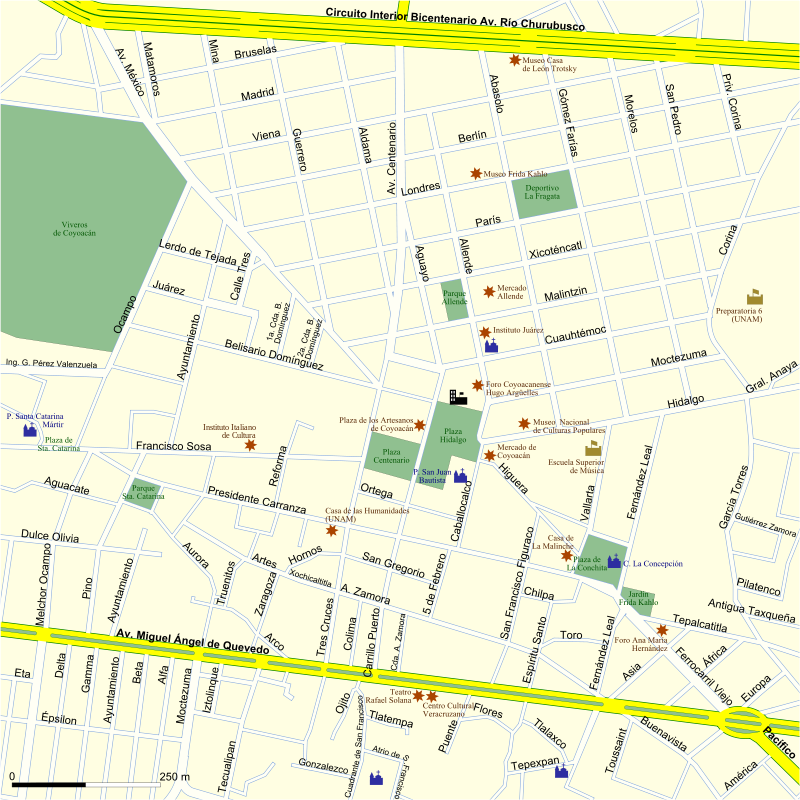
Exploring Coyoacan
Coyoacan is a Nahautl word meaning ‘place of the coyotes’ and about the first thing you’ll see after getting dropped off at Jardin Centenario is the Coyotes Fountain.
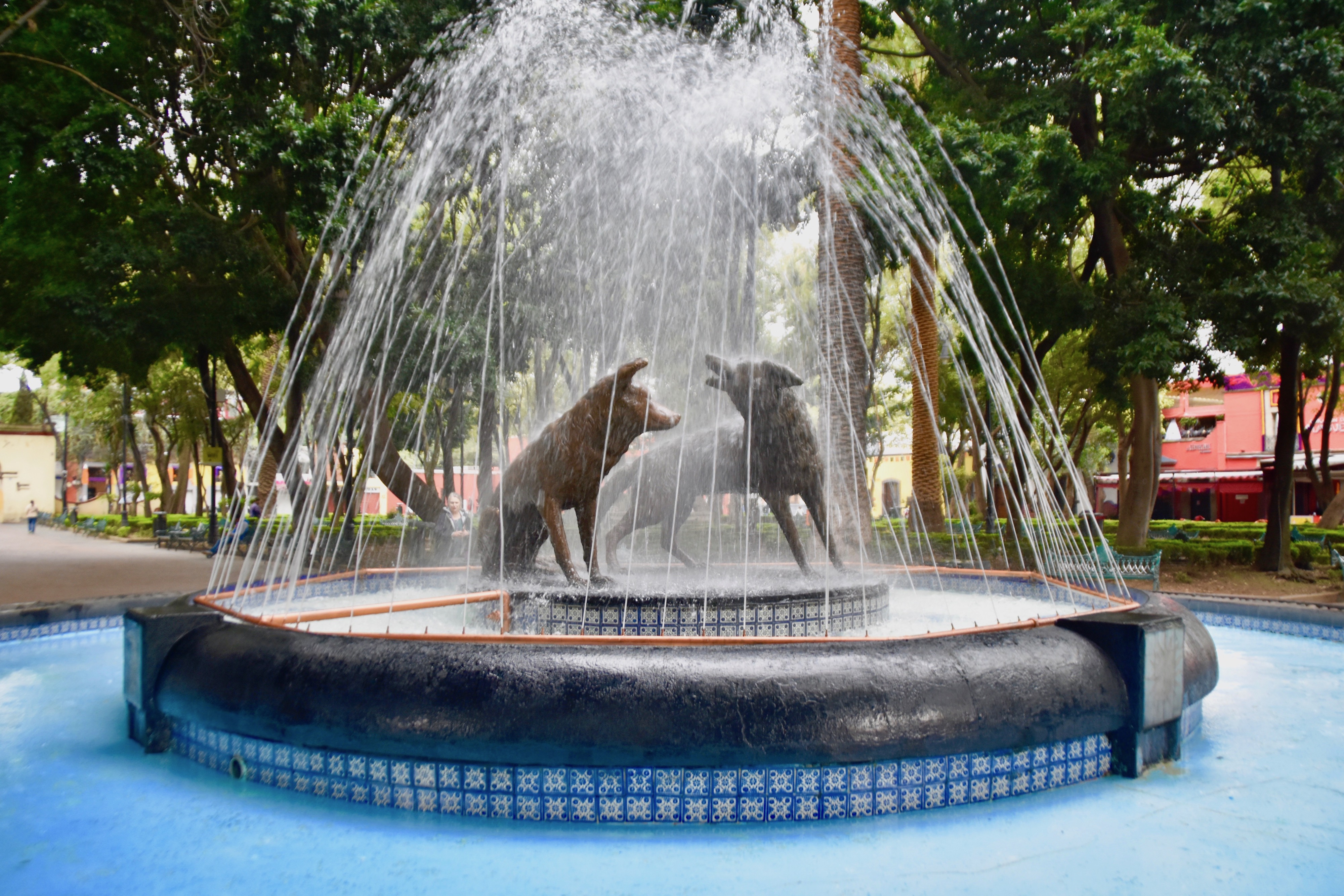
If you are here on a weekend the Jardin will be alive with families and young lovers out enjoying the greenery or sitting in the restaurants and cafes that surround it. Mexico City, for all its size, has a remarkable amount of green space and this is one of the nicest. This is a view looking across to the bandstand and Cortes palace – more on that later.
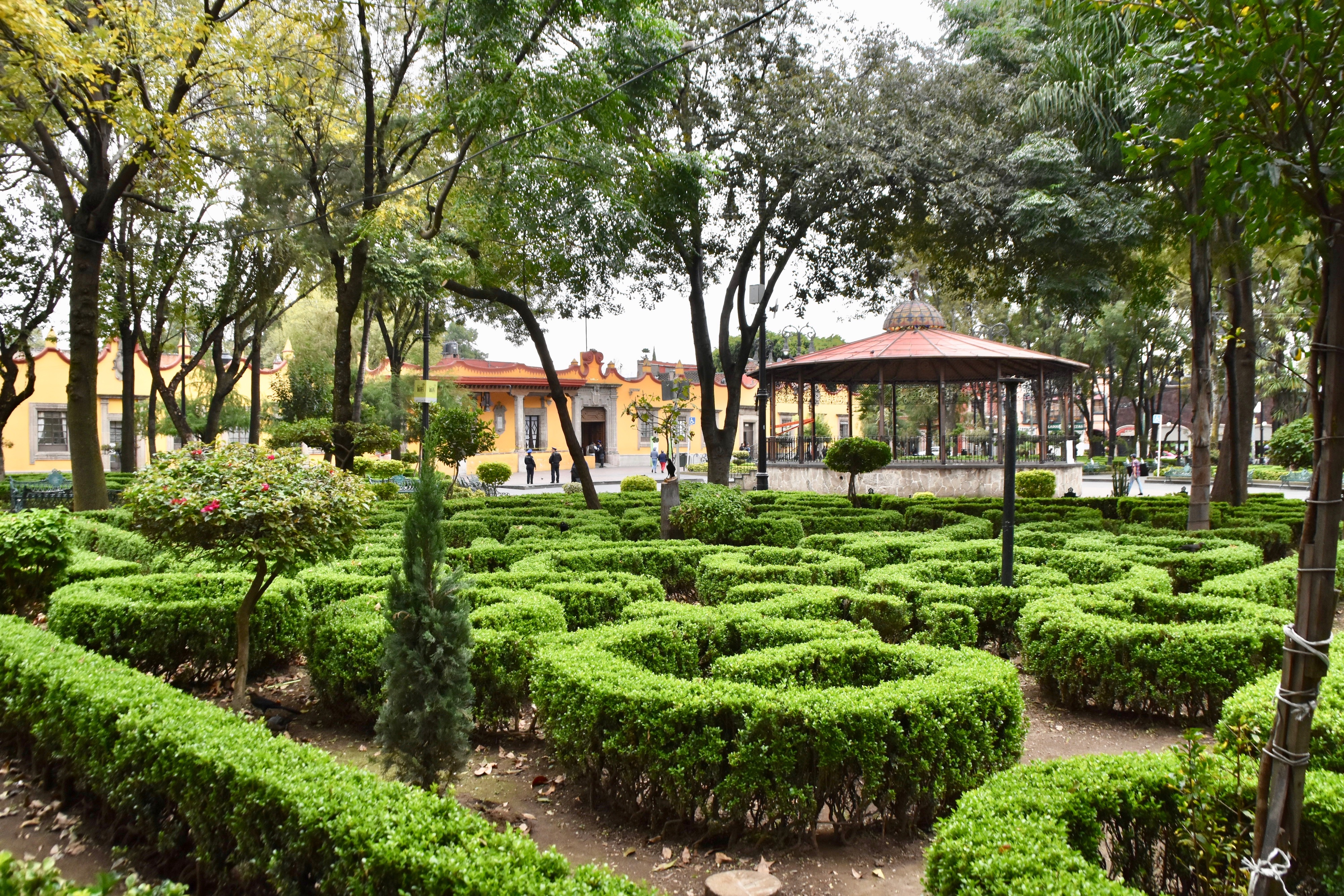
The coyote motif is everywhere in Coyoacan from rooftops.
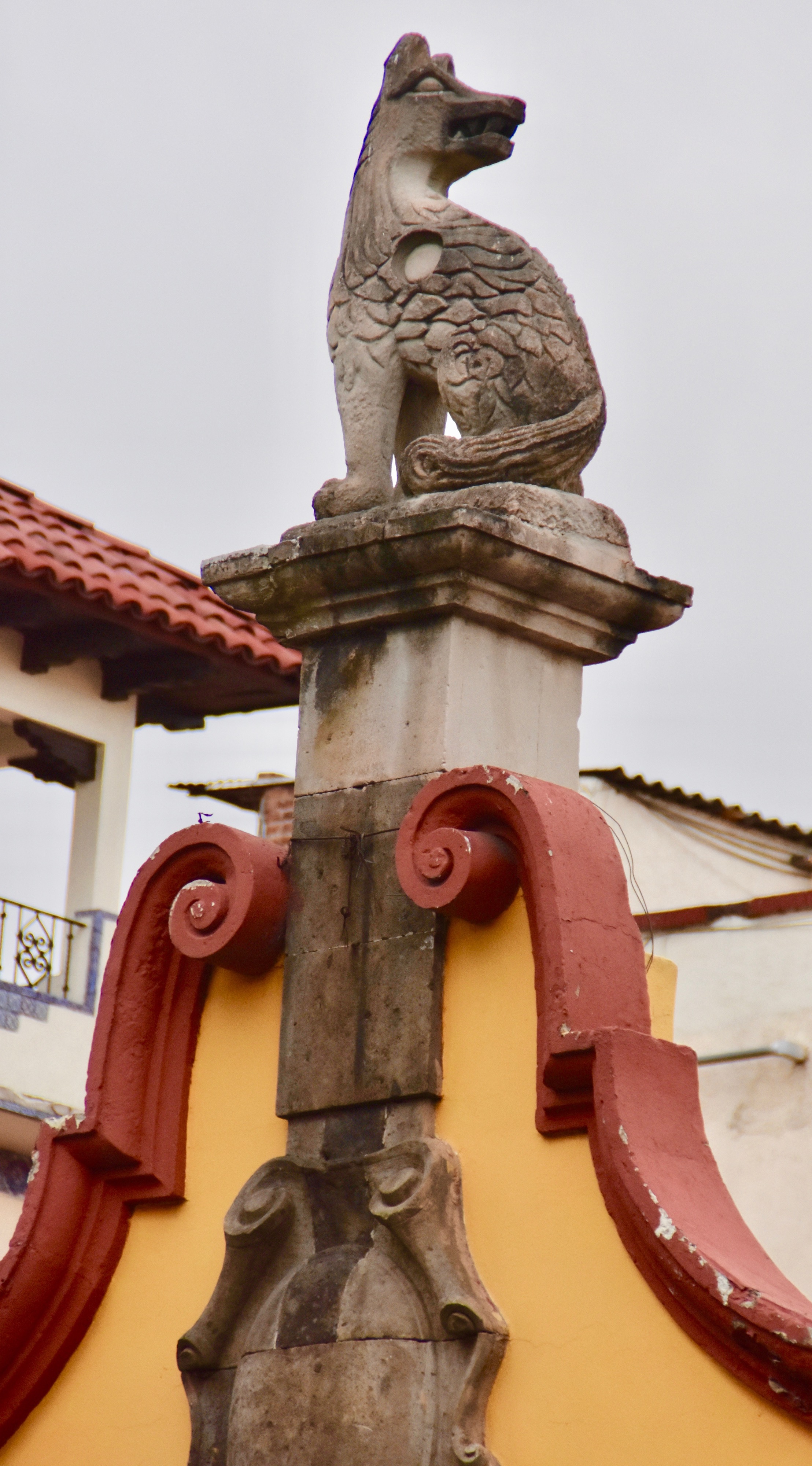
To the park benches.
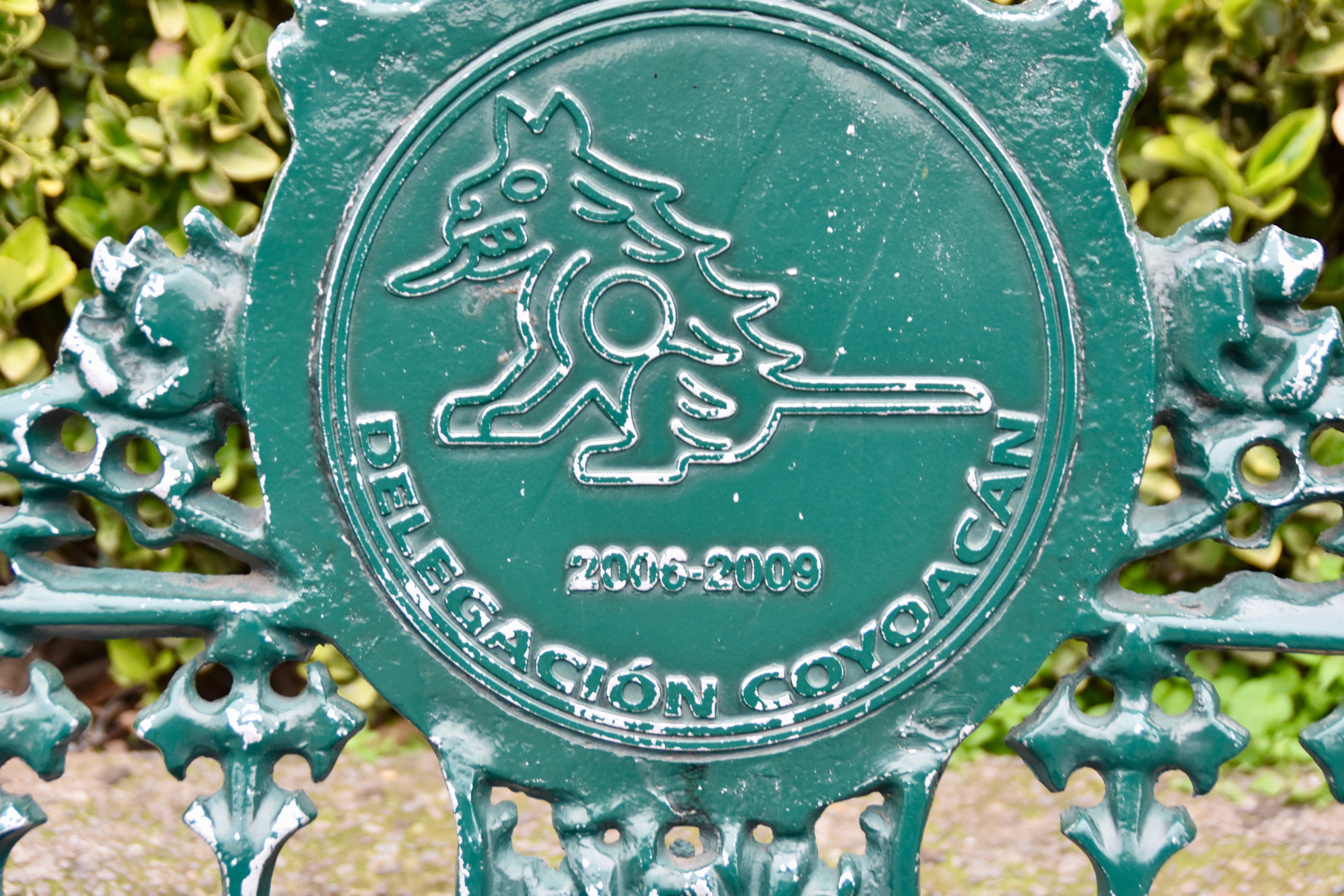
To the manhole covers beneath your feet.
Just across from Jardin Centenerio is the Church of San Juan Bautista (John the Baptist) and convent, parts of which date as far back as 1522 when Cortés granted land to build a religious complex on top of what had been an Aztec school. In front of the church is a cross allegedly dating from the foundation of Coyoacan, but I have my doubts.
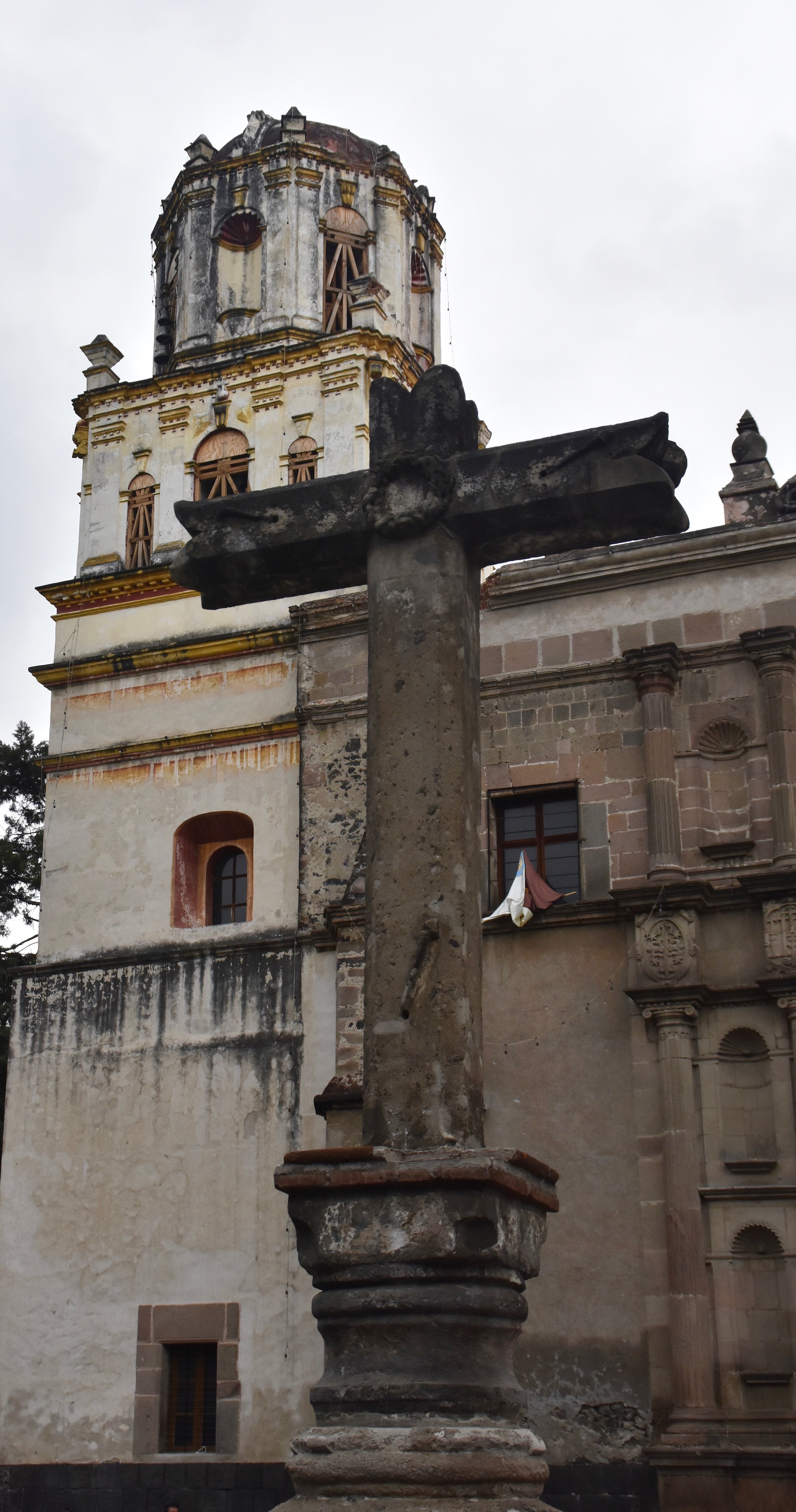
The church is definitely worth dropping into just to view its lovely interior, in particular its ceiling. Chances are if you are here on the weekend there will be at least one wedding party and you’ll get a chance to see the absolutely over the top dresses that Mexican bridal parties like to wear.
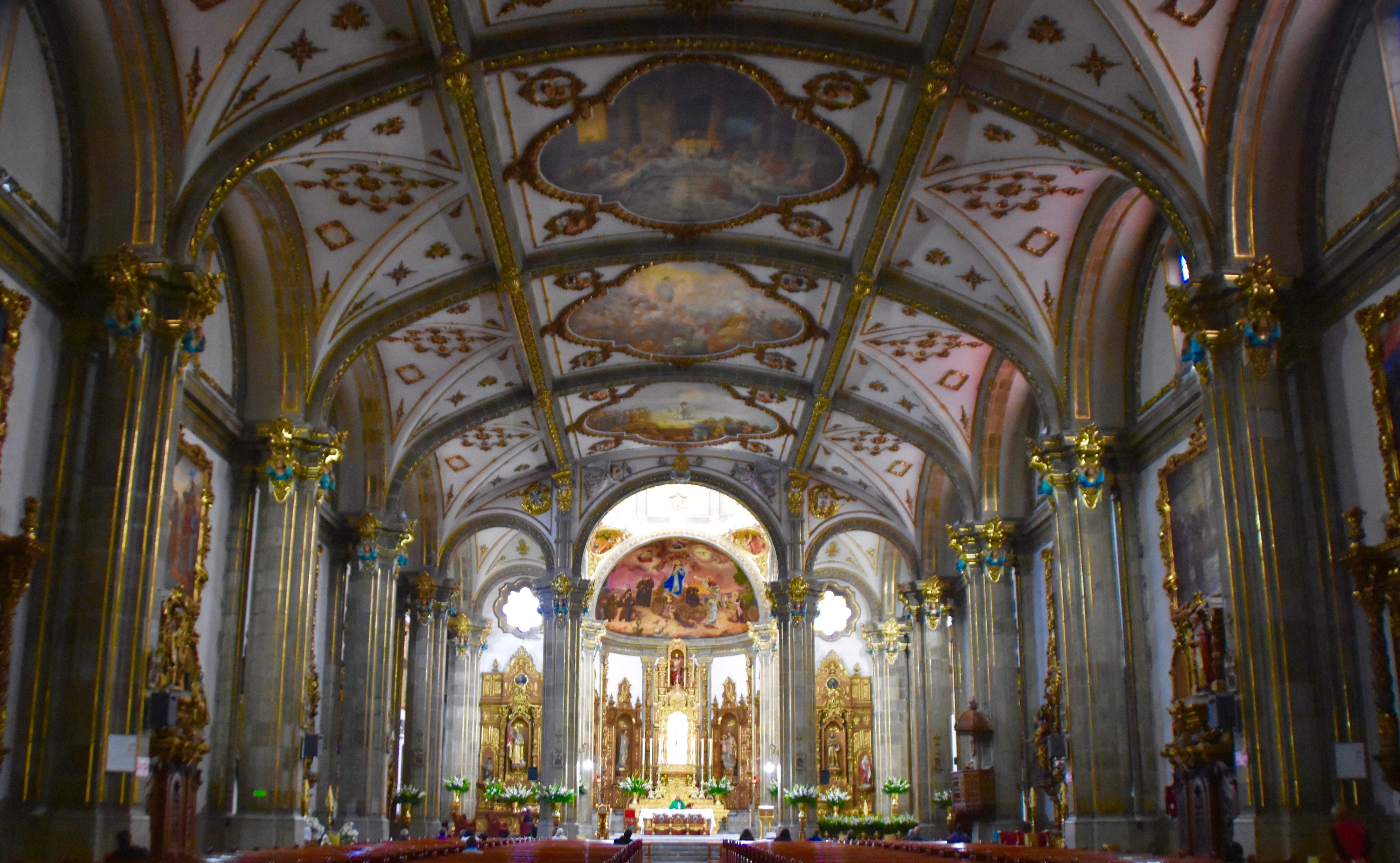
Mexican depictions of Jesus Christ are very popular and tend to be more realistic than many you might see in a European or North American setting. No blue-eyed blonde haired saviours here, but real black hair from native Mexicans.
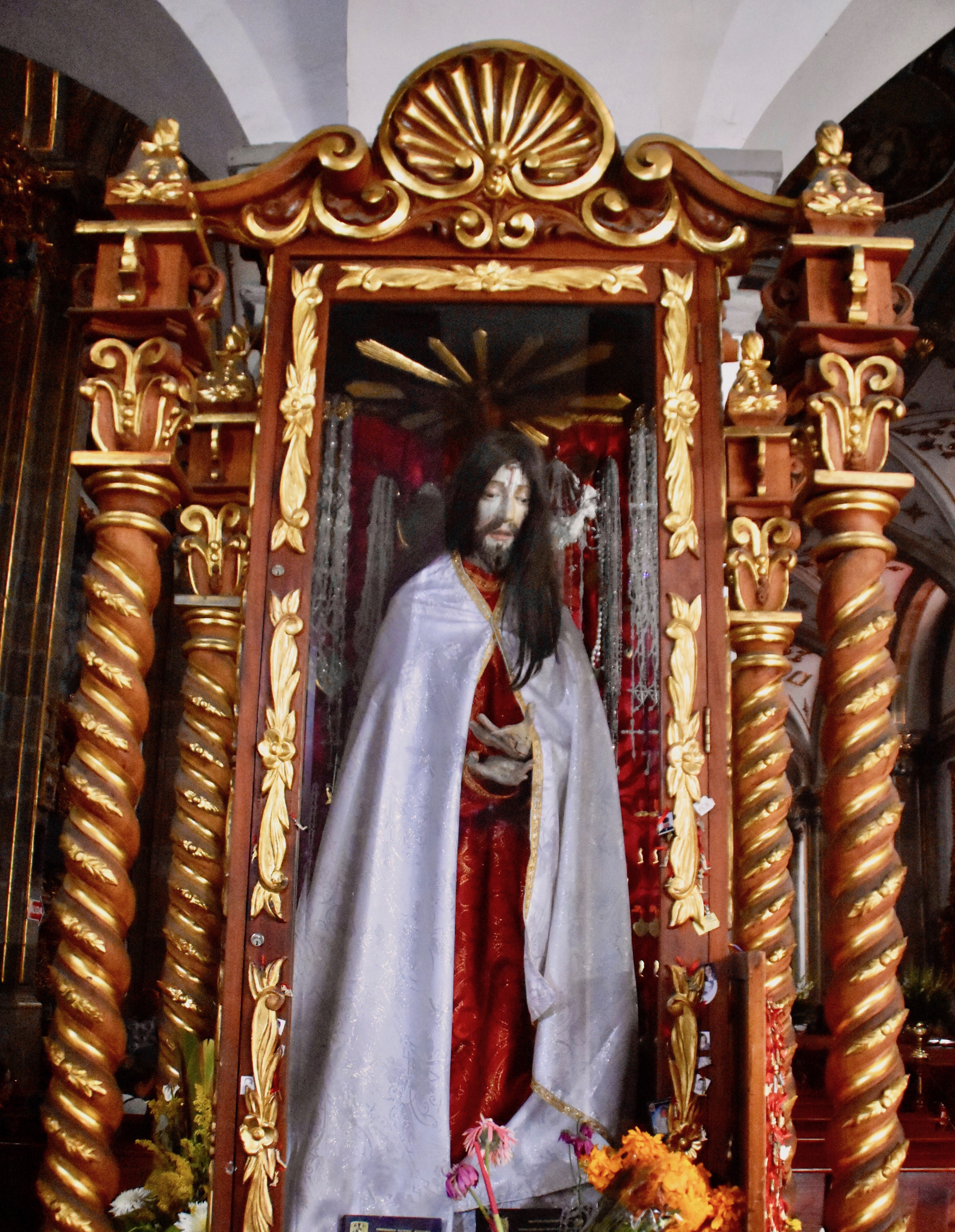
The Rosario Chapel is the most opulent of seven in the church and a prime example of Mexican baroque workmanship. All I could do was just shake my head.
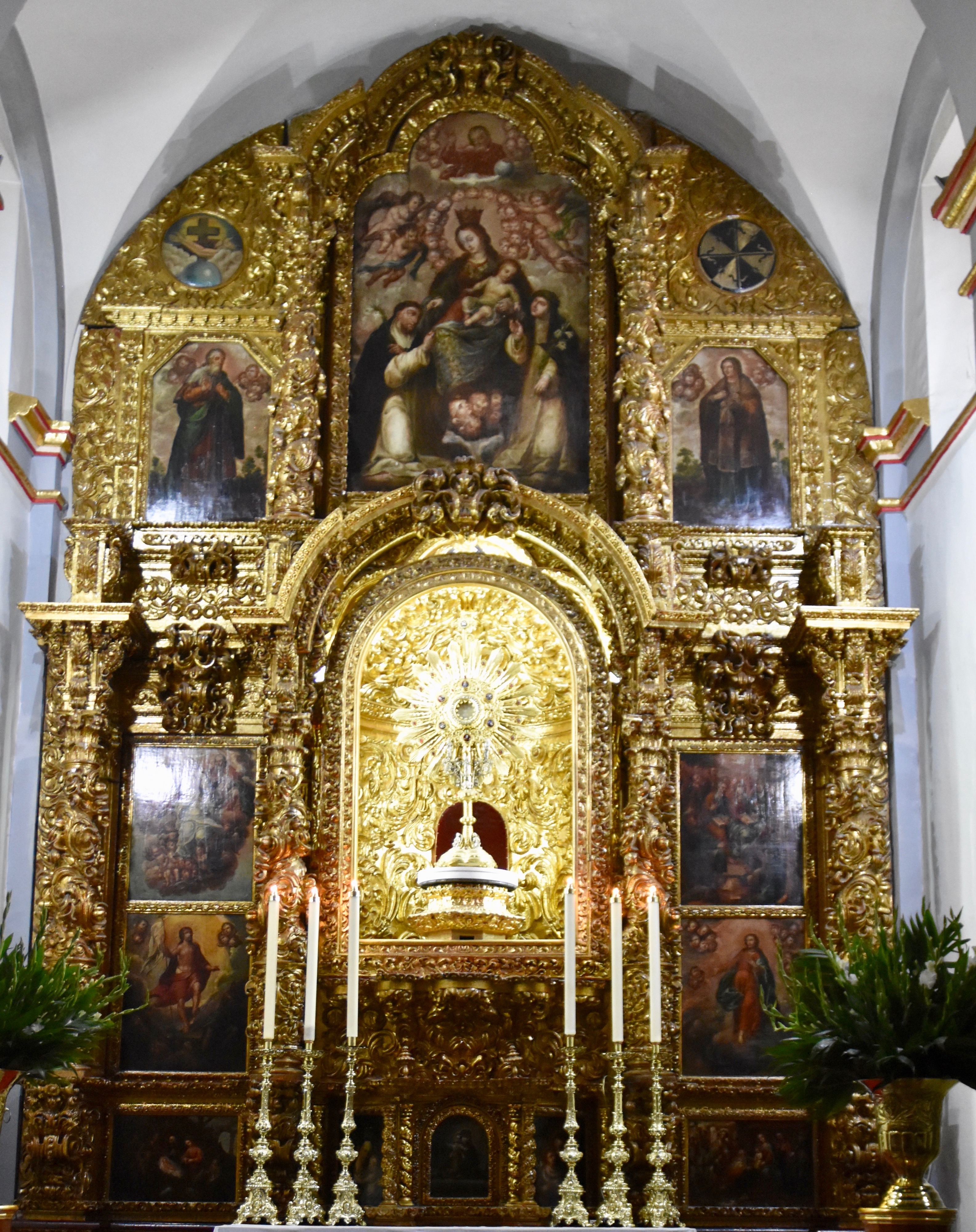
Just behind the church is the Coyoacan Mercado where there are a great number of places to sample the everyday foods that most Mexicans enjoy. The day we were here the eating area was so packed we couldn’t find a spot to sit. It’s also a great place to just poke around for Mexican handicrafts or maybe try some marzipan which always looks great, but is cloyingly sweet.
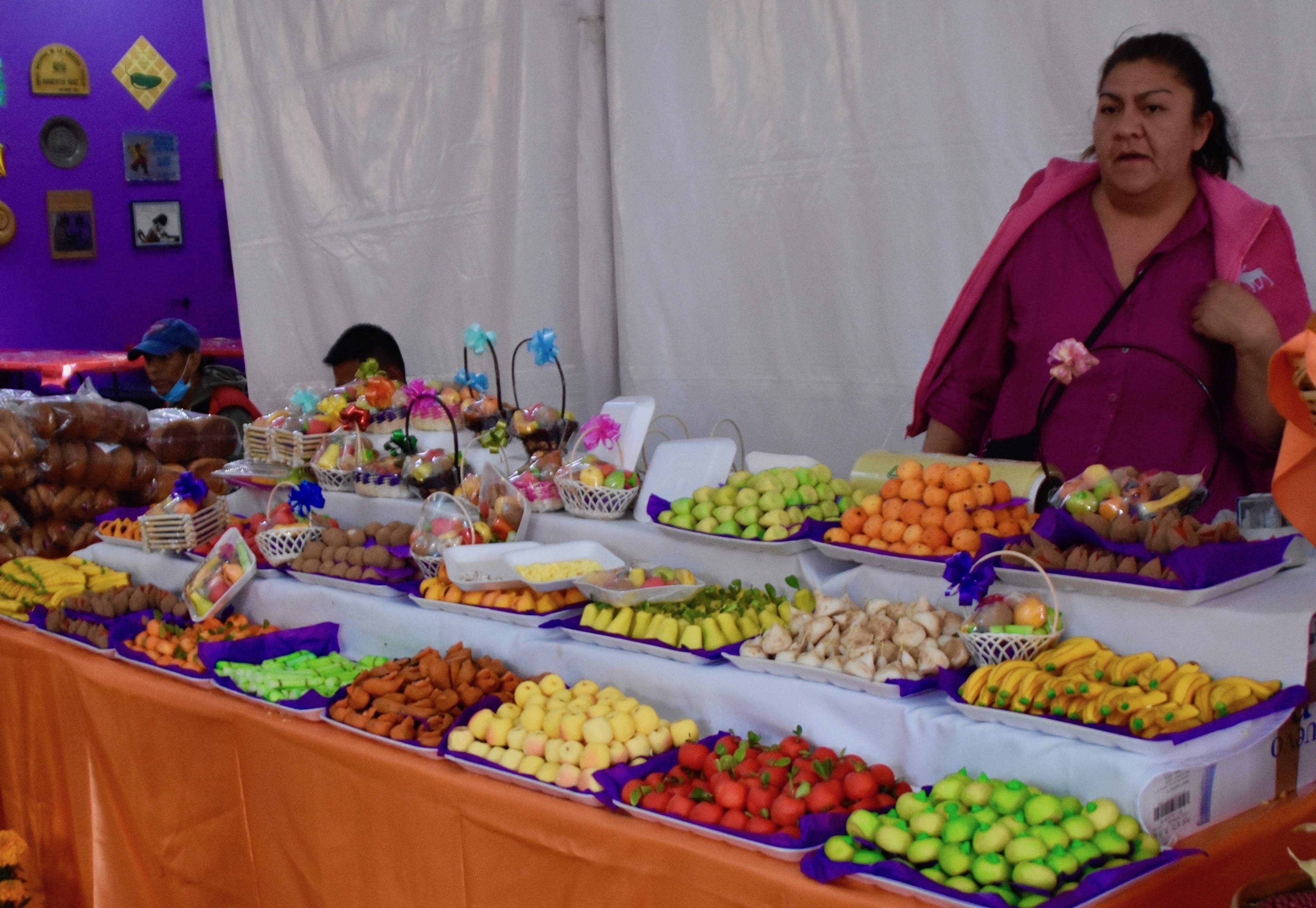
Also in this immediate area is the often incorrectly named Palace of Cortés, which is actually the Coyoacan municipal building that dates from the 1700’s, two centuries after Cortês lived here. All traces of his original palace are long gone. Still, it’s a nice colonial style building bordering the greenery of the Jardin.
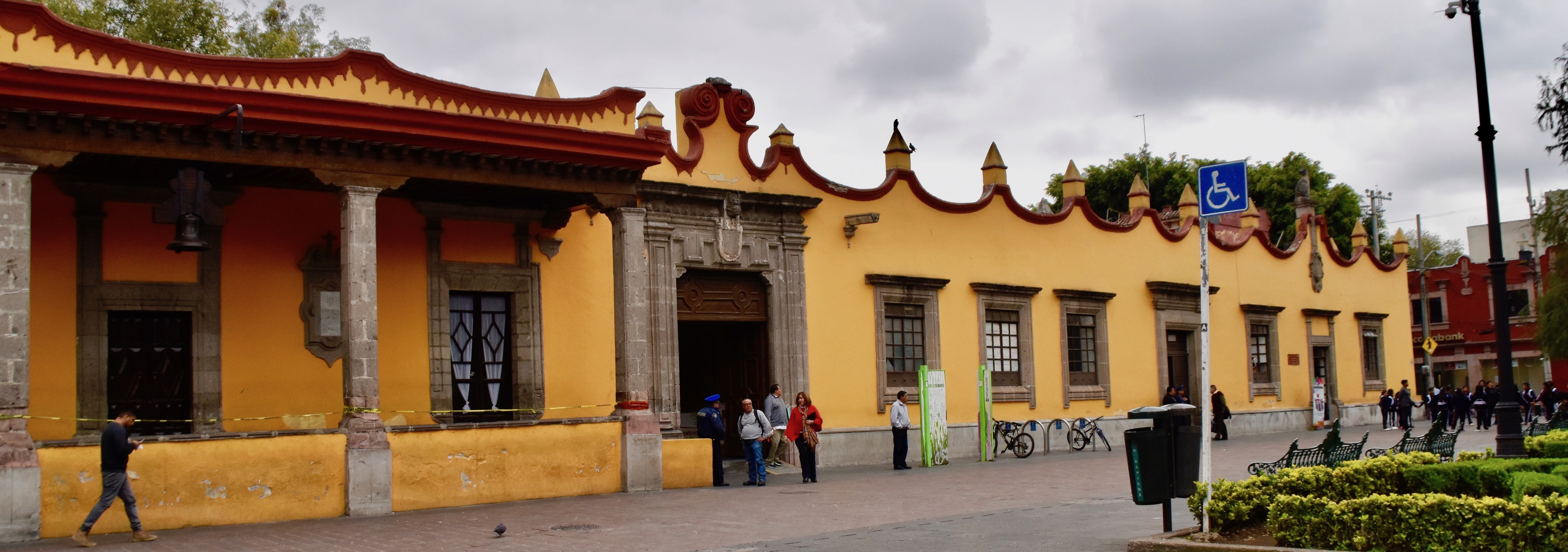
One final stop in the area around Jardin Centenerio and Plaza Hidalgo is in front of this very interesting collage creation that tells the story of Mexico. Perhaps no country in the world excels Mexico in its visual depictions of its history, particularly in the works of its famous muralists. This work is a continuation of that process.
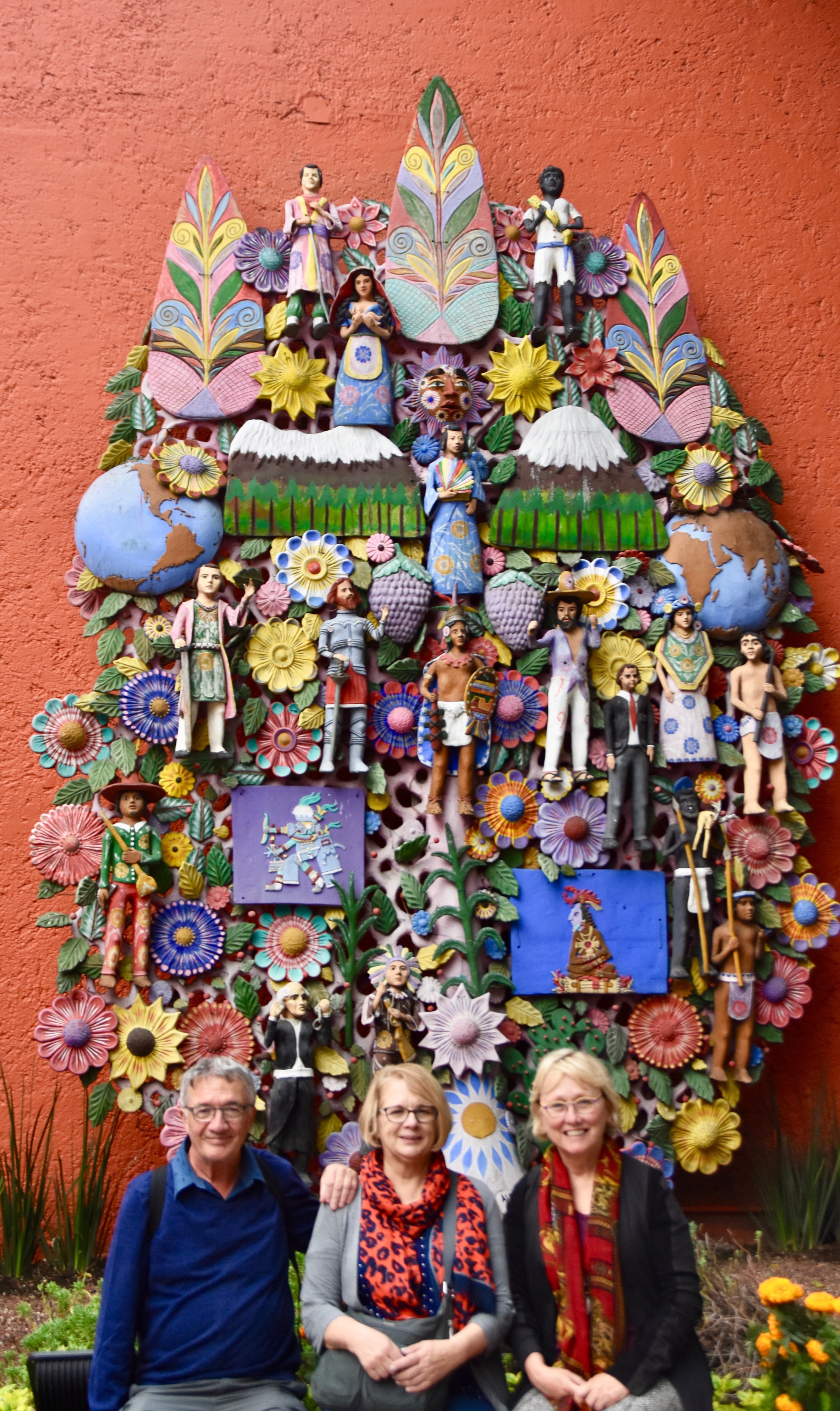
Coyoacan was one of the first places we visited on a recent trip to Mexico with Canadian company Adventures Abroad on a tour that included many of the top pre-Columbiam sites in central Mexico. However, it also included visits to the great colonial cities where many of the most important events in Mexico’s colonial and post colonial period took place. At the time I had this picture taken I could identify maybe a few of the figures depicted in it, but looking at it now I can identify most. For example, that’s Miguel Hidalgo immediately above my left shoulder; easily identified for his flowing grey hair and the broken chain in his hand. Just as gothic cathedrals in Europe told stories from the Bible in stone and wooden sculpture for the masses so at the beginning of this tradition in Mexico the stories were told in bright colour on the sides of buildings. I am glad that the tradition continues today.
After spending the first fews hours in Coyoacan in a very small area, it is time to wander through the narrow streets to the attraction that brings most foreign visitors to the area and the one place you will almost always find line ups – the Frida Kalho Museum.
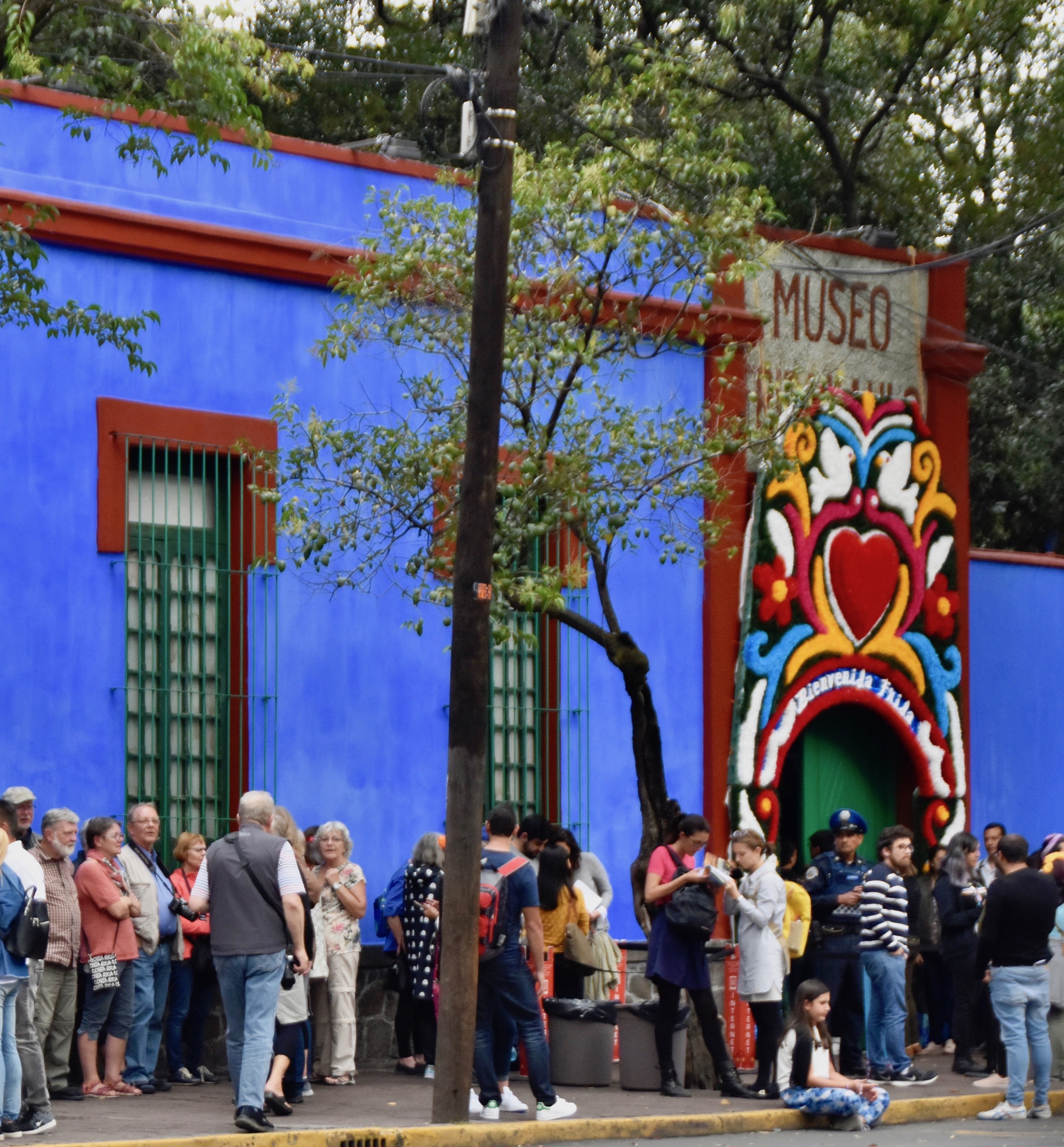
Frida Kahlo has become an industry in modern Mexico with her picture everywhere and nowhere more so than at the Blue House where she was born and died. Walking to the museum is a very pleasant stroll from the centre of Coyoacan, but whether one wants to brave the line ups is another matter. I didn’t. It’s not that I don’t respect the legacy of Kahlo, although I do think it’s overblown, I just found too many other interesting things to see in the area that I couldn’t spare an hour or more waiting in line to speed through a tiny crowded house. This picture was taken on a Monday when the rest of Coyoacan was completely quiet; imagine what it would be like on a busy day.
Aside from the Frida Kahlo Museum there is also the Leon Trotsky Museum where the ex-pat Russian Bolshevik leader lived in exile and was murdered at Stalin’s behest.
Coyoacan and the Day of the Dead
I visited Coyoacan twice on the trip to Mexico, the first with just myself, my wife Alison and my sister Anne on a Saturday during the height of the Day of the Dead festivals. It was very busy with a festive air that was helped by the music or organ grinders (they’re all over Mexico and even have a union) and mariachi bands. I took this video from the balcony of Sanford’s restaurant overlooking the Jardin Centenerio and then up to the church. Excuse my garbled pronunciation of Coyoacan.
The Day of the Dead takes place not on one day as the name suggests, but over many and is anything but a sombre occasion. Every business in Coyoacan dresses out their building with marigolds and other flowers, skeletons and skulls – here’s just a few of the restaurants.
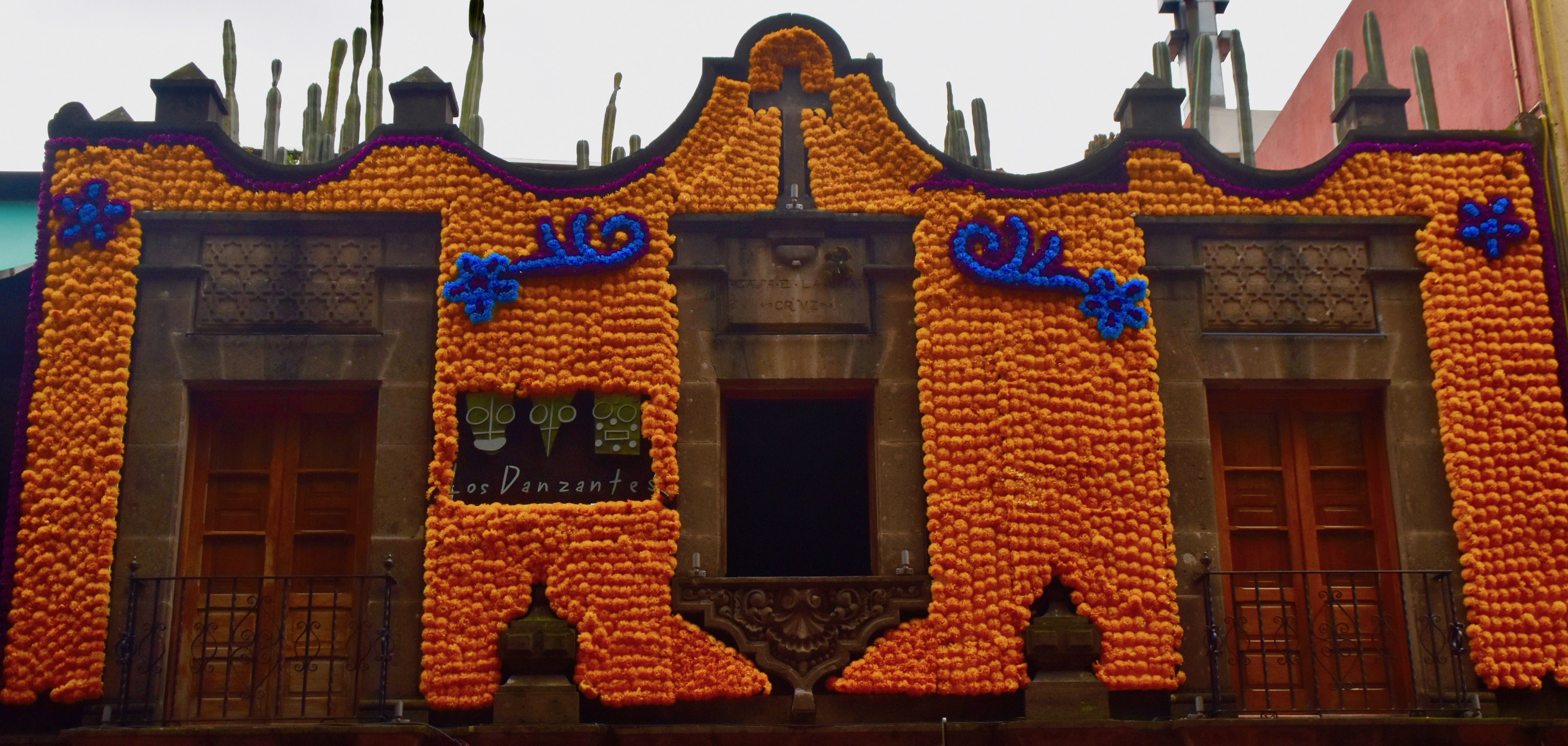
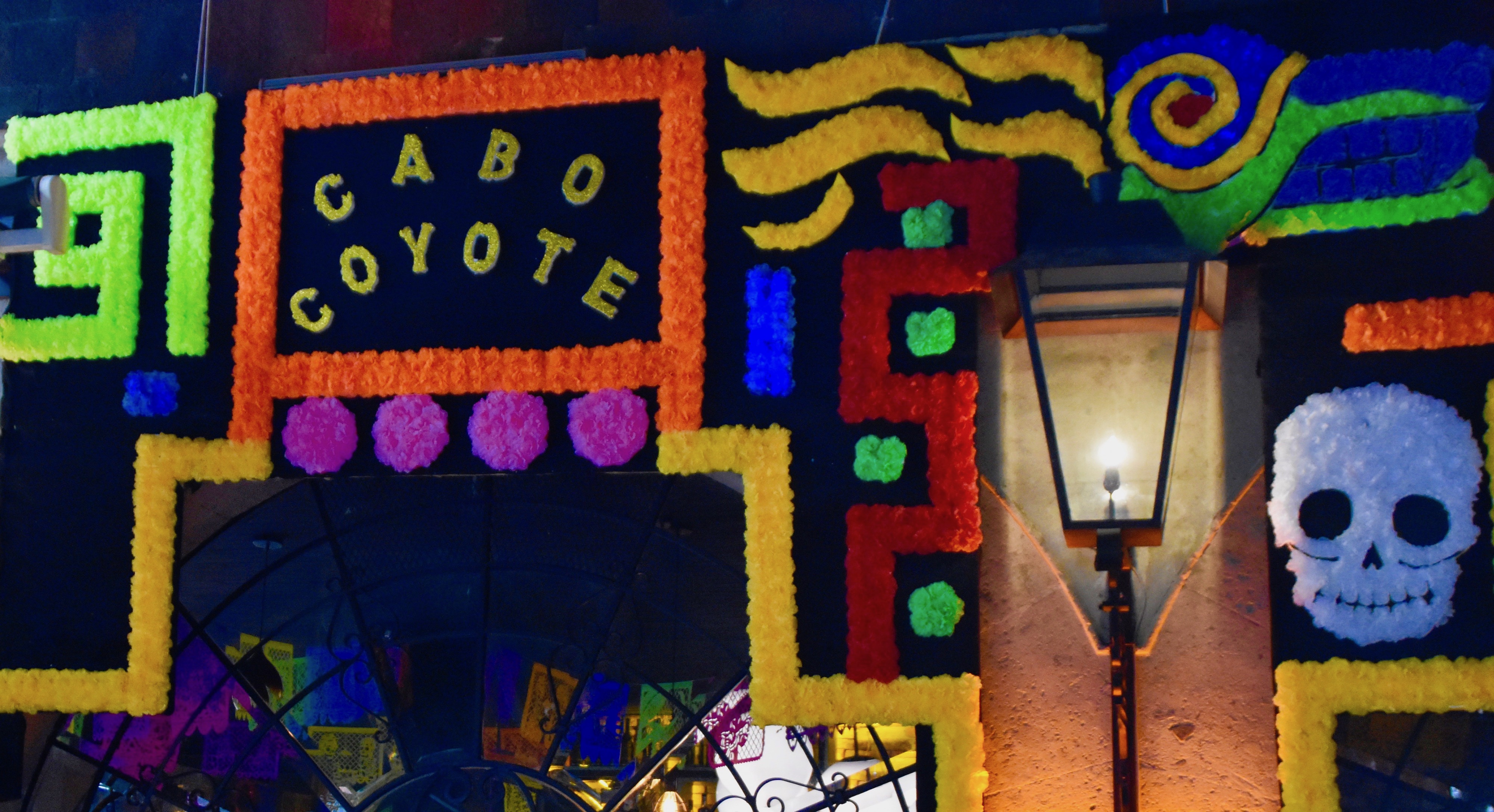
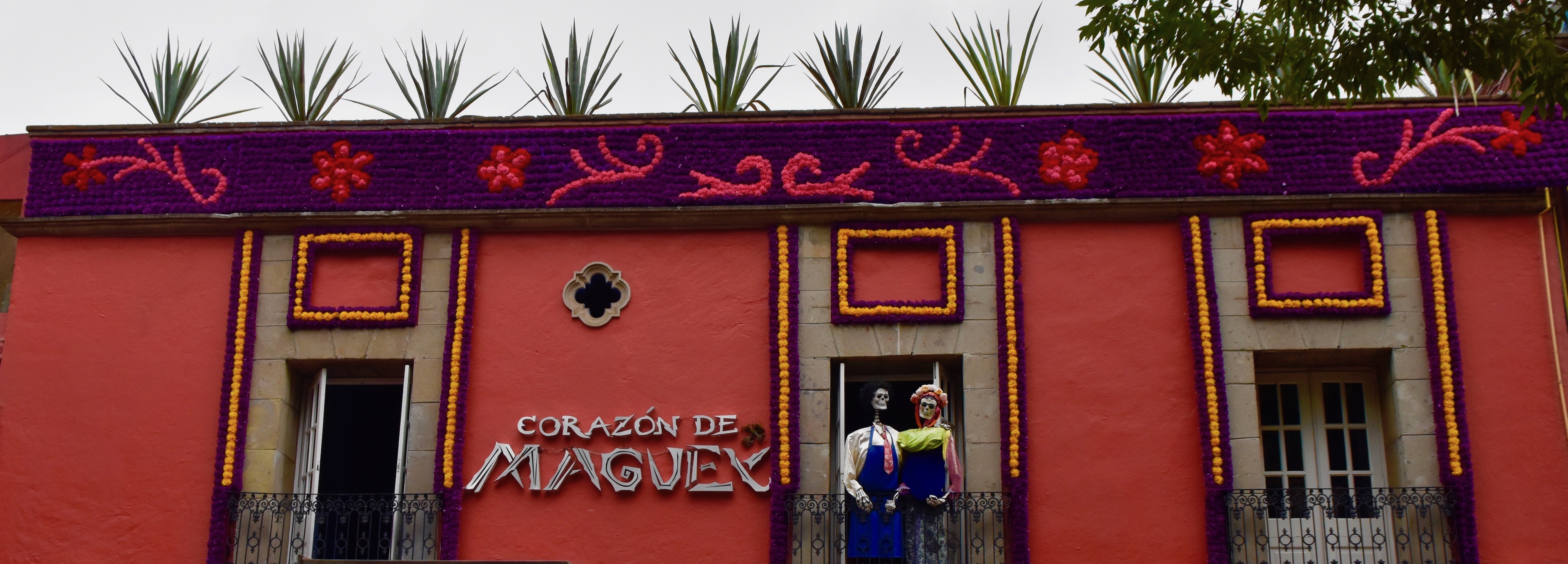
Talk about a long wait for service – I think these two starved to death.
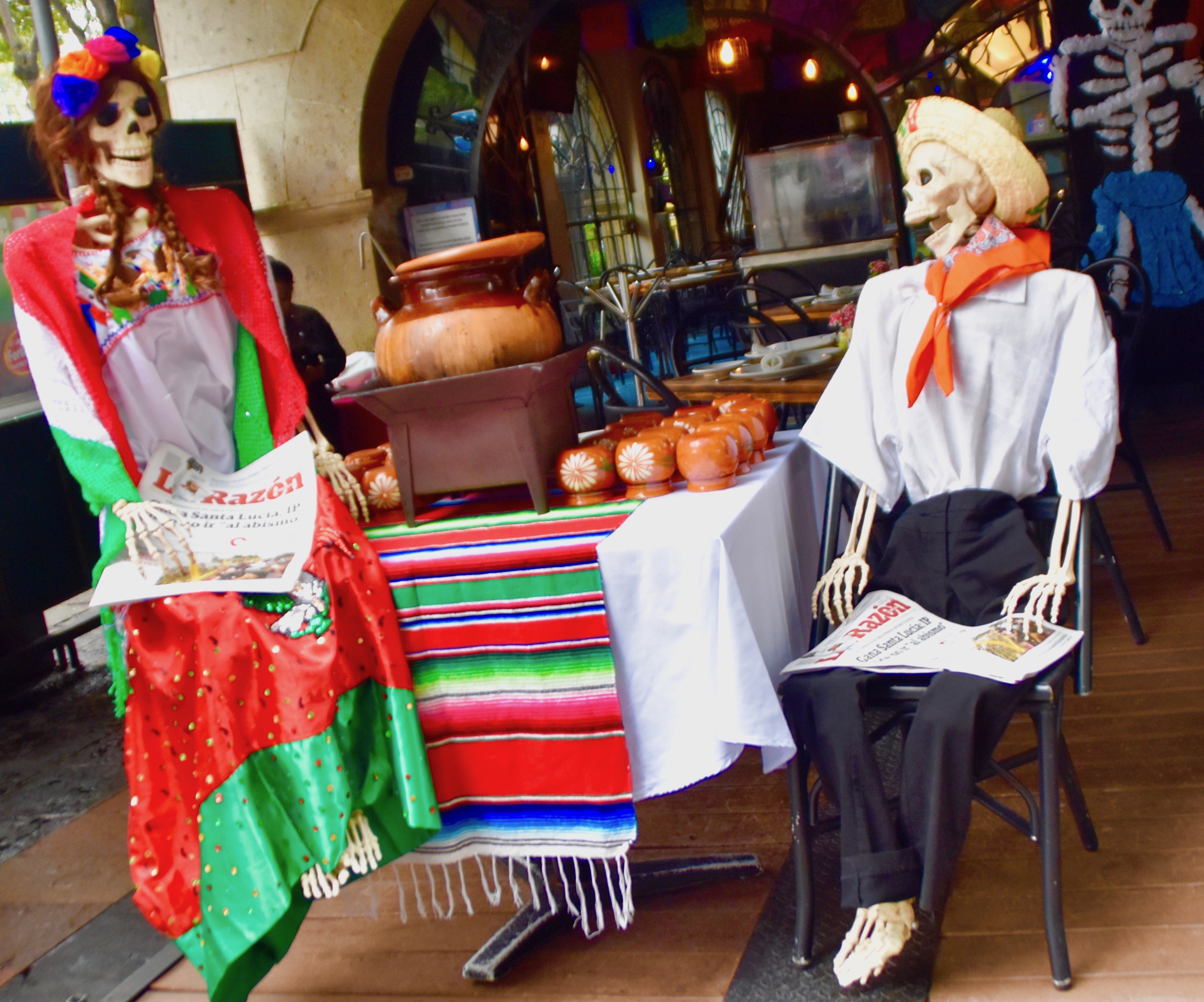
When I sat down at Sanford’s I had this guy as a lunch companion.
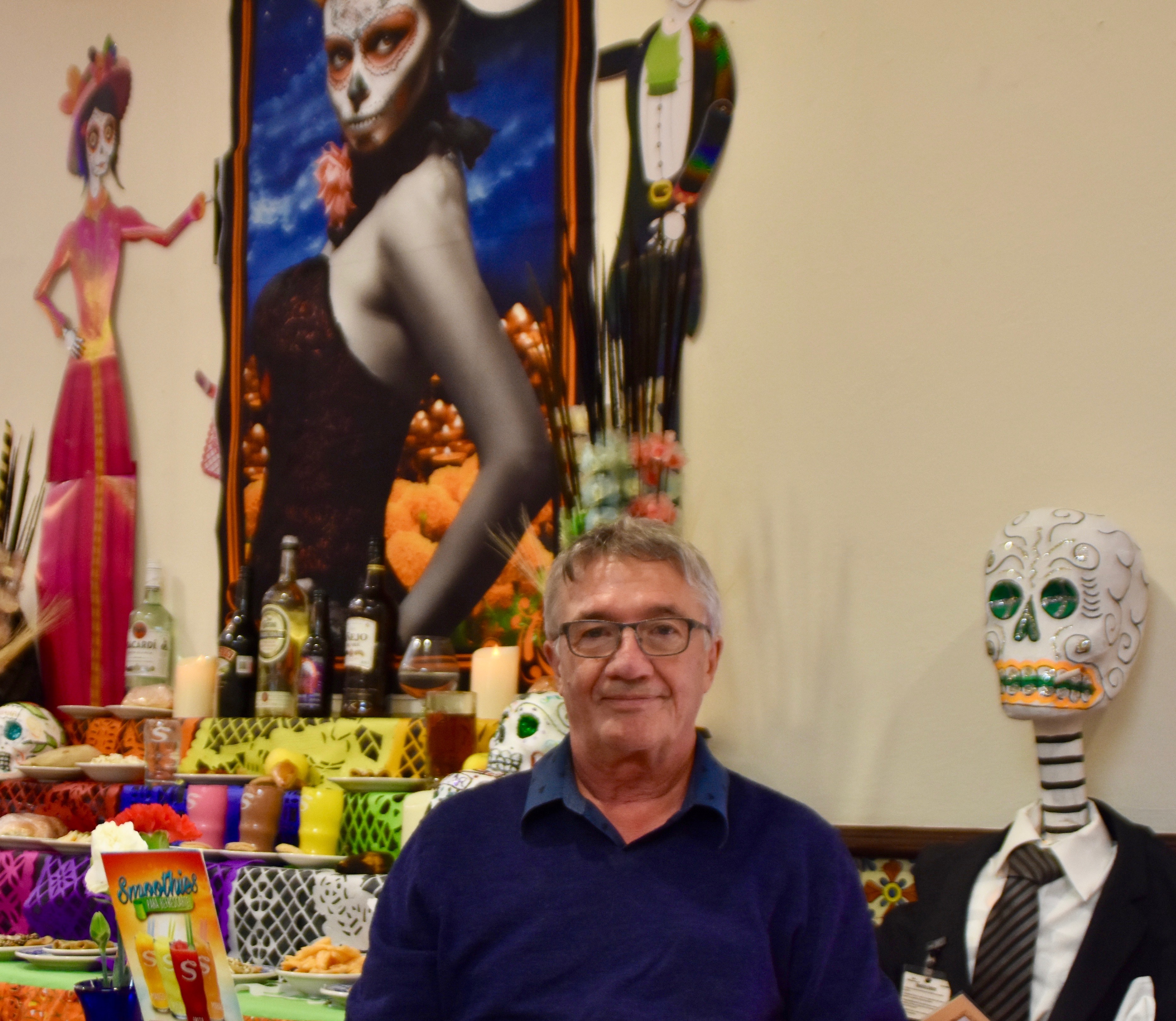
Outside the church near the cross there was a large gathering where this woman was haranguing the crowd about I know not what.
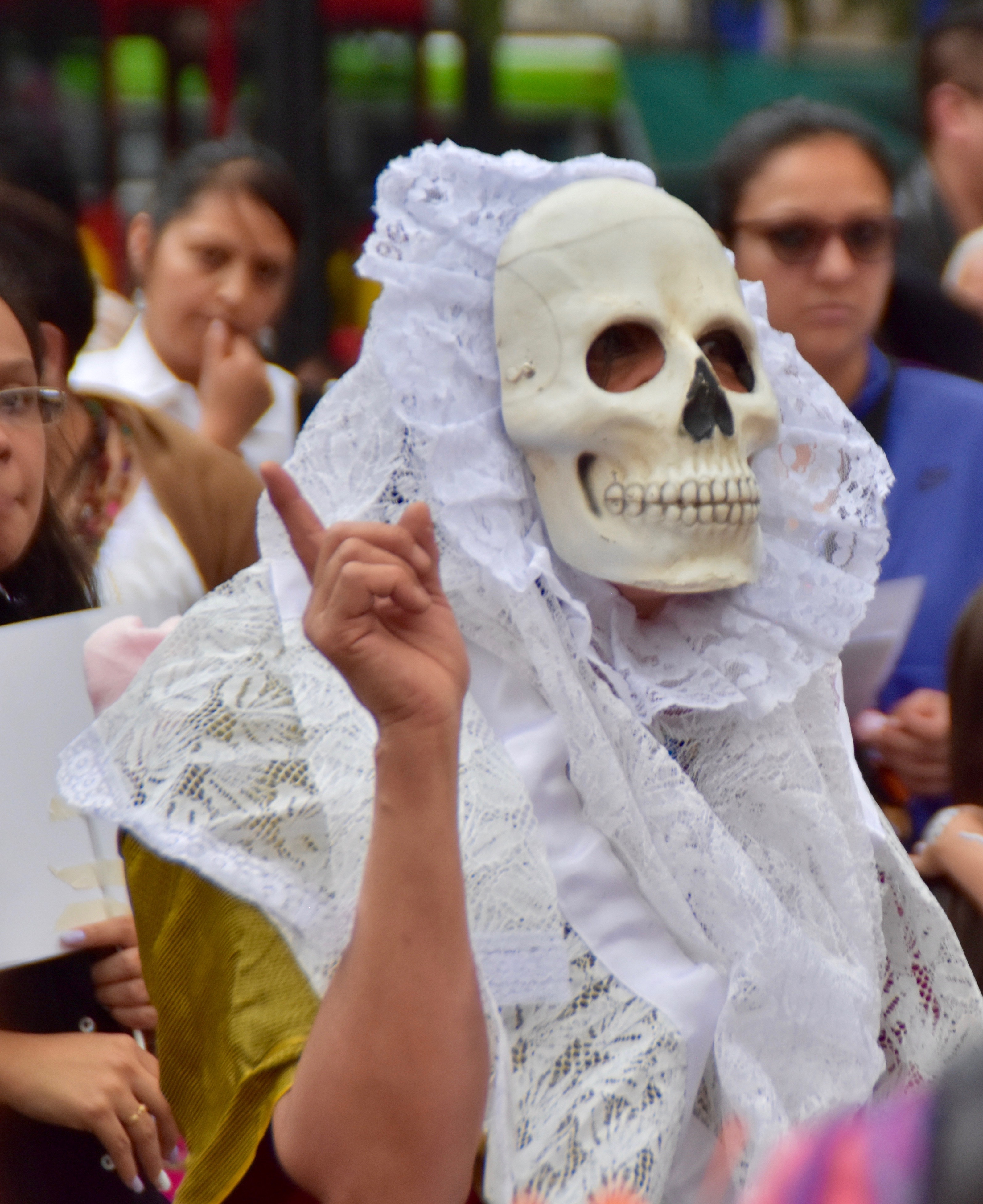
In and around the market there were numerous Katerinas, the satirical put downs of the Spanish bitches who used to travel back to Spain to have their babies so they could be Spanish citizens.
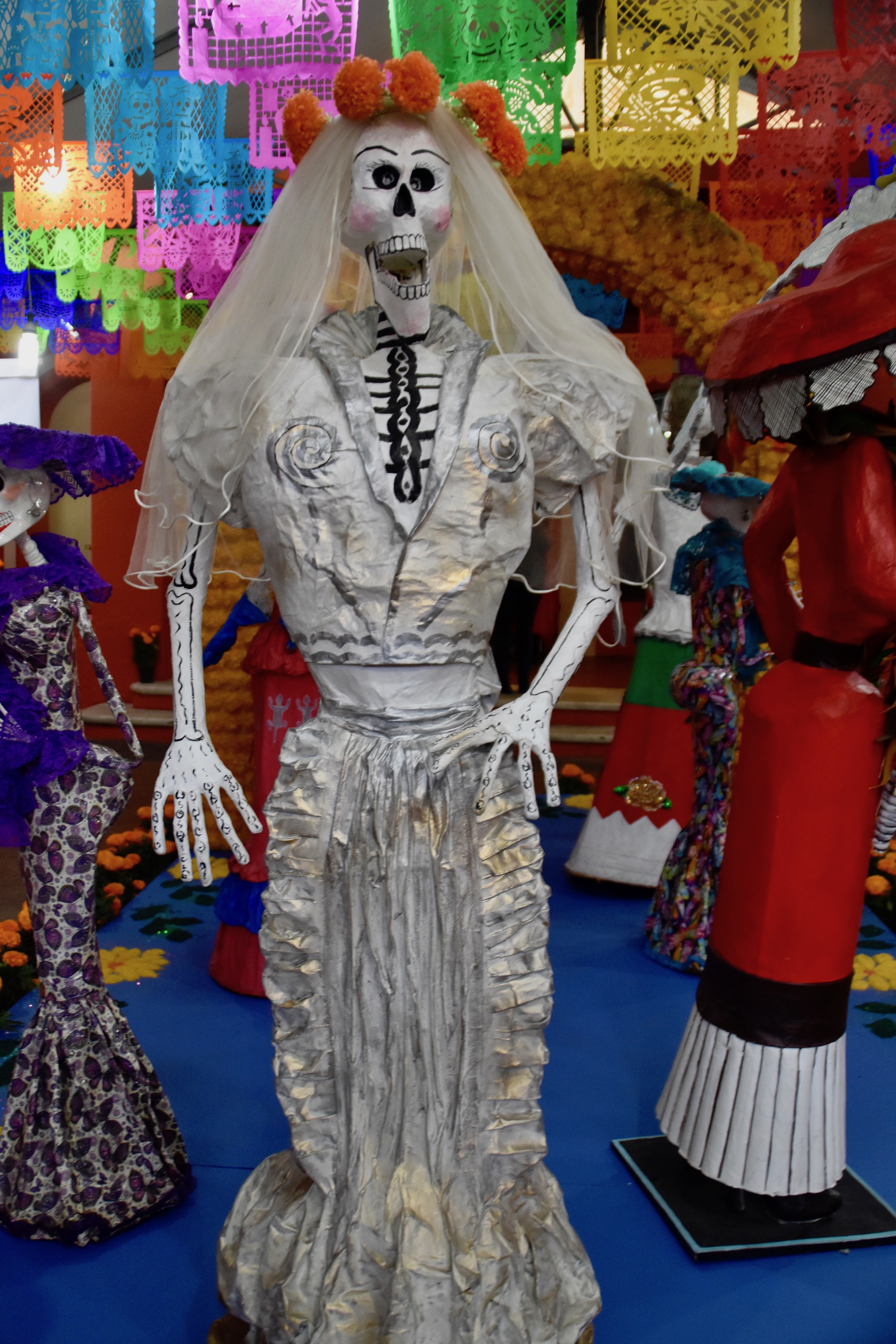
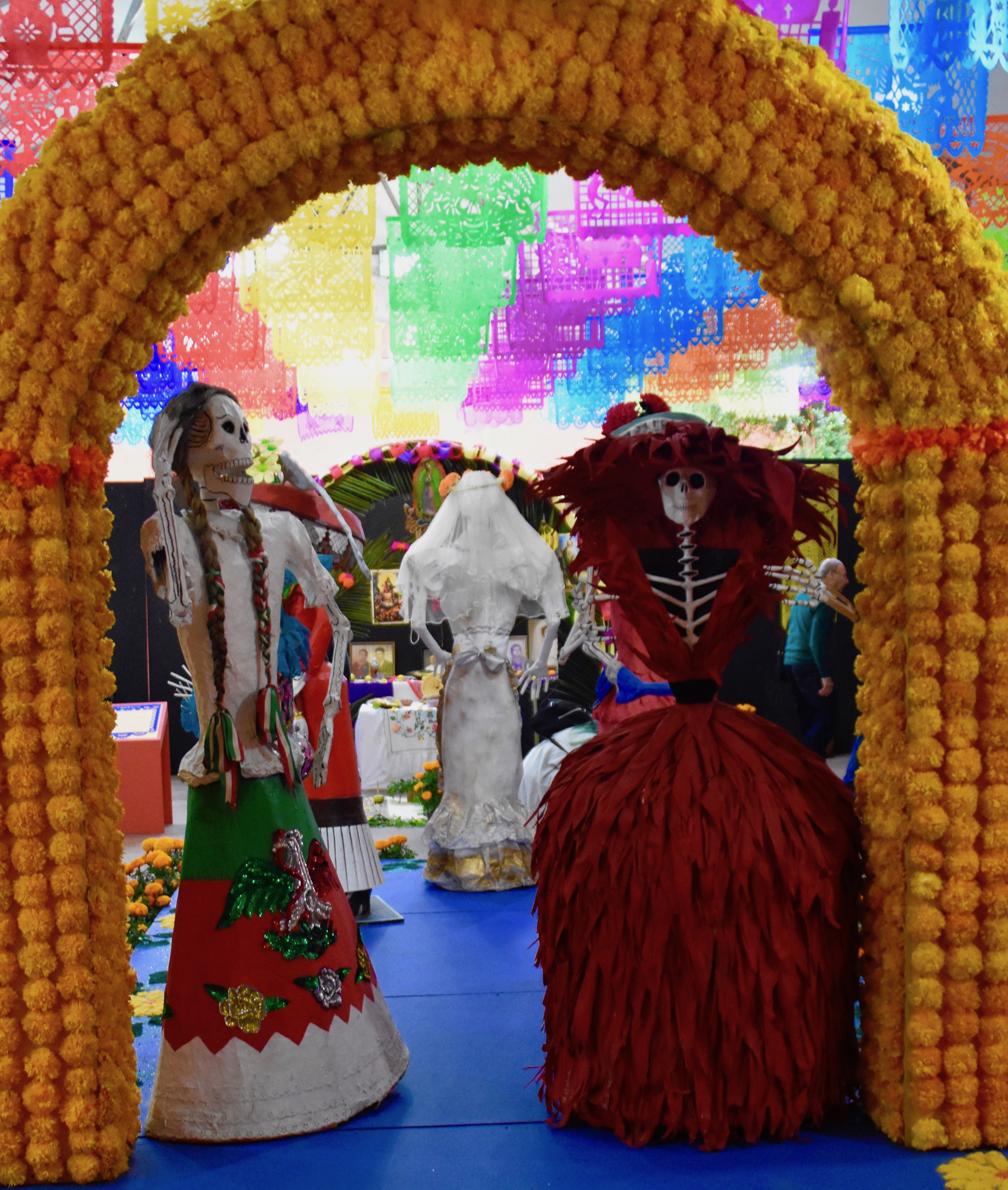
Every business, institution and individual home in Coyoacan had erected a Day of the Dead altar, many of them personalized like this one to honour lost parents.
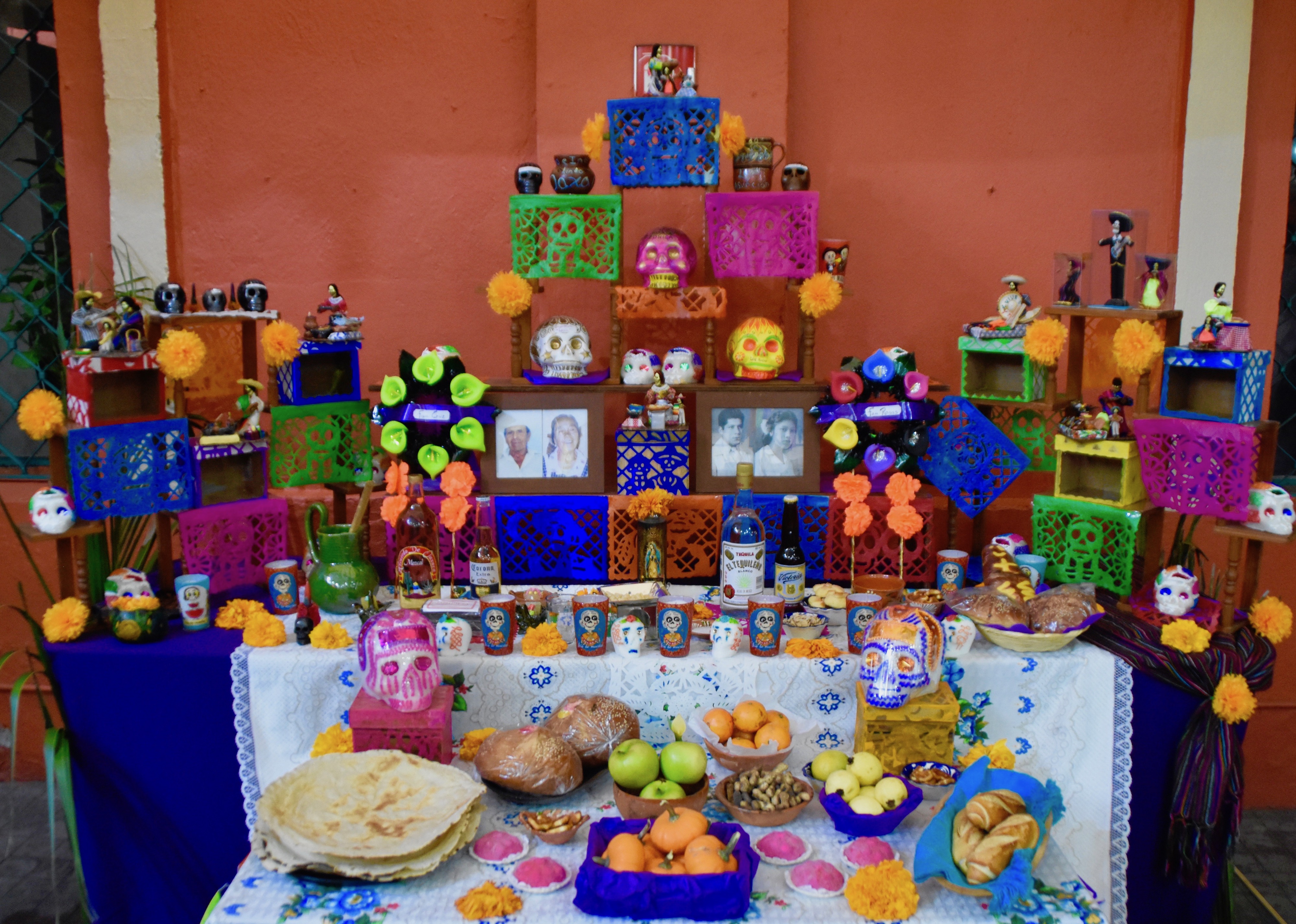
Vendors were doing a great business selling dolls, skulls and all thing related to the Day of the Dead.
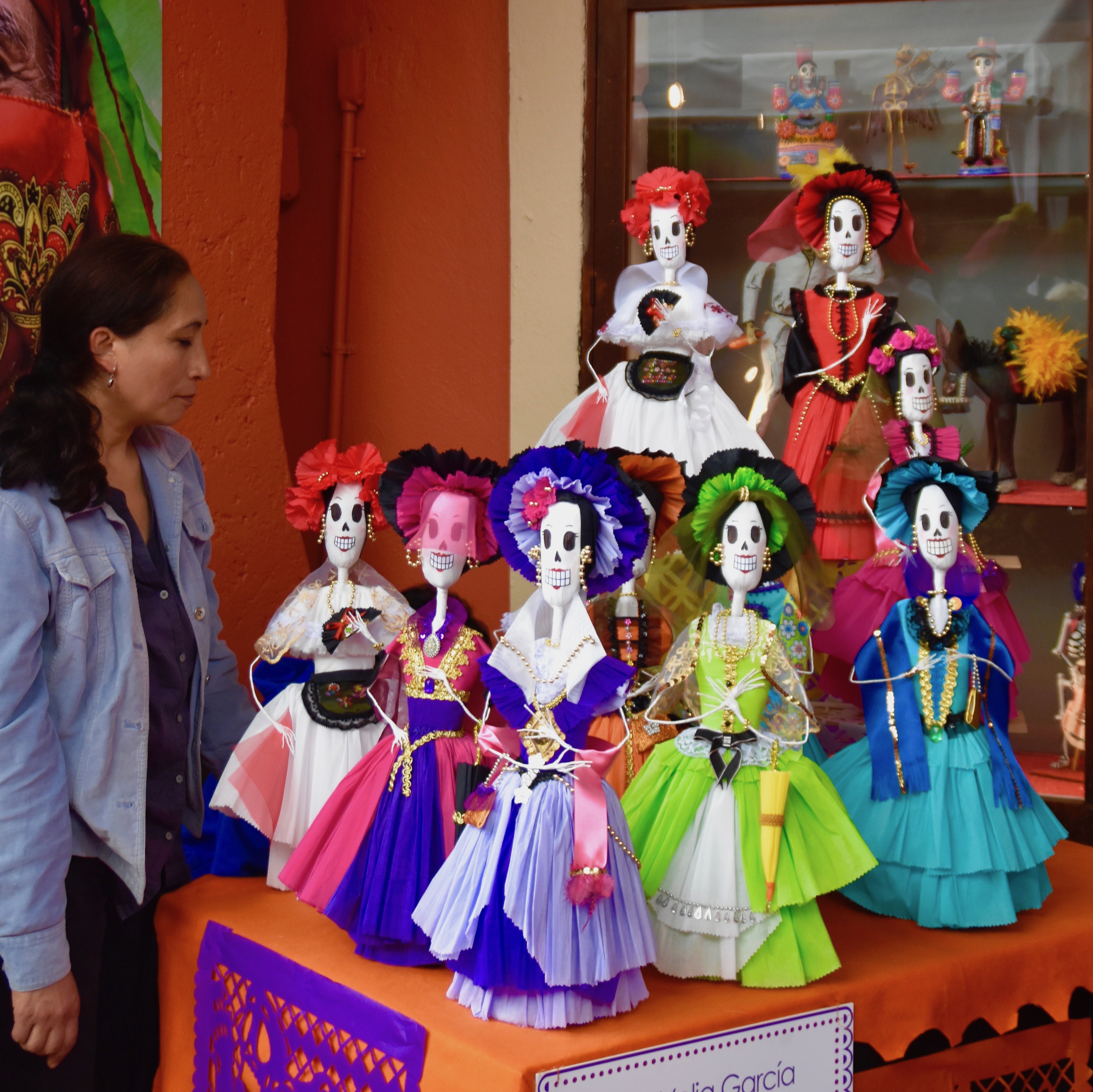
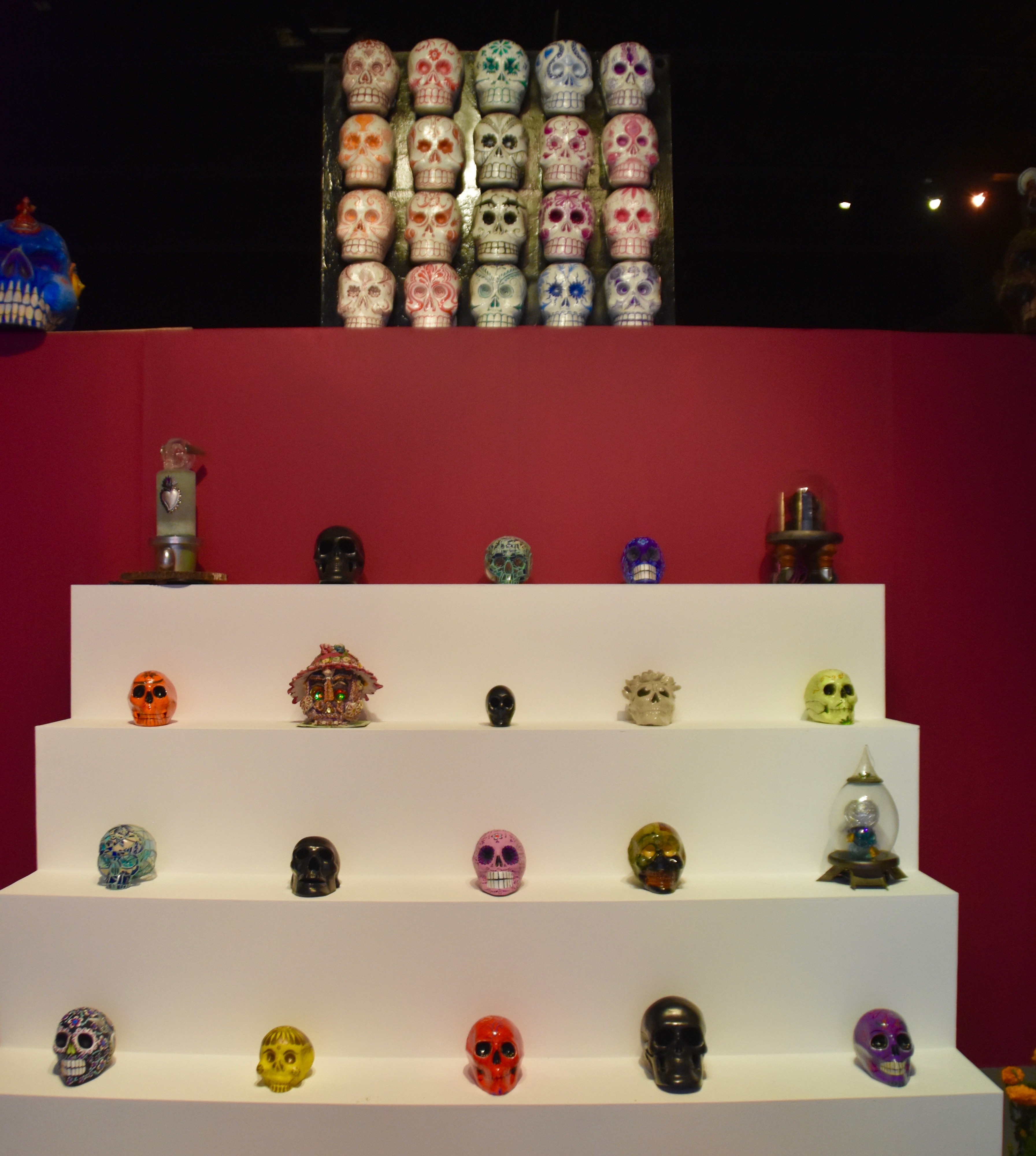
Needless to say it was colourful, exciting and unlike anything we had ever seen. If you are in Mexico City during the Day of the Dead time, say from late October through mid-November, be sure to make the trek out to Coyoaca and really get into the spirit of things.
Many thanks again to Dale of The Maritime Explorer for taking the time to write such an excellent recap of this adventure. Stay tuned for more.